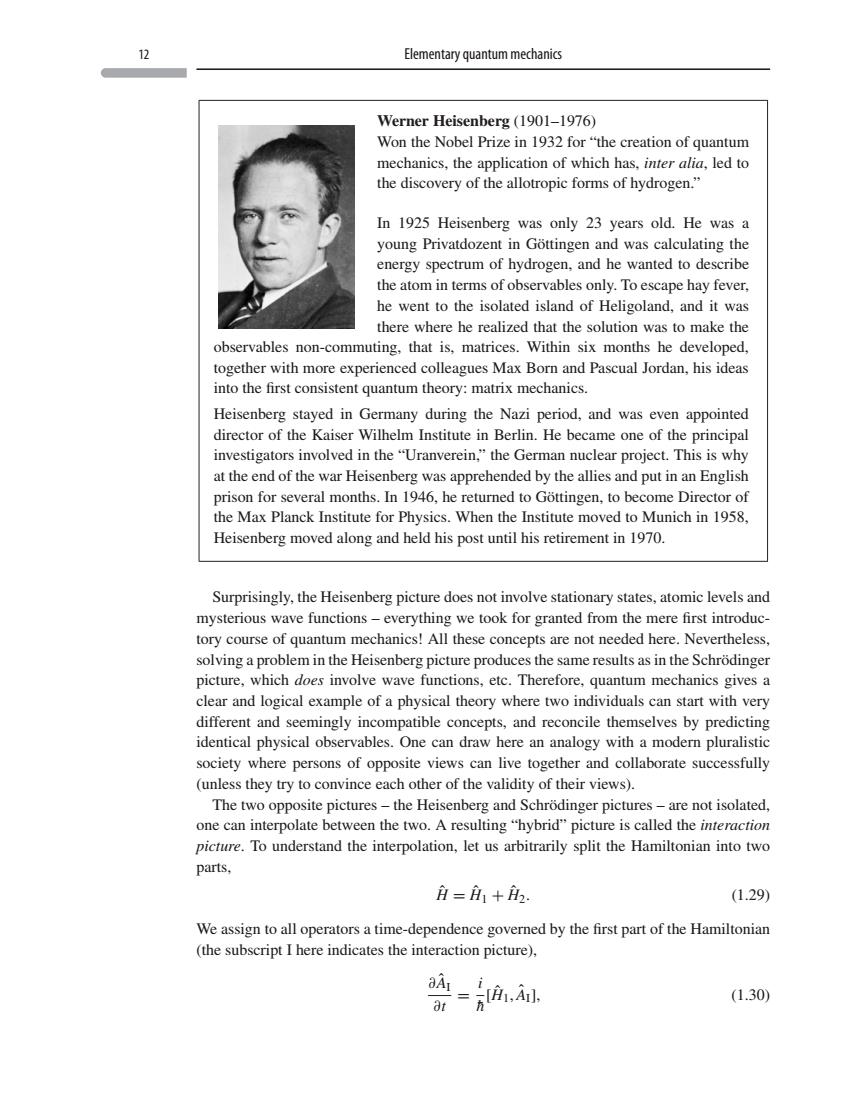正在加载图片...

2 Elementary quantum mechanics Werner Heisenberg(1901-1976) Won the Nobel Prize in 1932 for"the creation of quantum mechanics,the ppli ation of which has nter led to the discovery of the allotropic forms of hydrogen.' In 1925 Heisenberg was only 23 years old.He was a young Privatdozent in Gottingen and was calculating the energy spectrum of hydrogen,and he wanted to describe the atom in te y.To esc ape hay fever he went to the isolated island of Heligoland,and it was there where he realized that the solution was to make the observables non-commuting.that is,matrices.Within six months he developed, together with more experienced colleagues max born and Pascual Jordan.his ideas into the first consistent quantum theory:matrix mechanics. Heisenberg stayed in Germany during the Nazi period,and was even appointed estiga at the endof the war Heisenberg was apprehended by the allies and prison for several months.In 1946.he returned to Gottingen,to become Director of the Max Planck Institute for Physics.When the Institute moved to Munich in 1958. Heisenberg moved along and held his post until his retirement in 1970. Surprisingly,the Heisenberg picture does not involve stationary states.atomic levels and mysterious wave functions ng we took for granted from the mere first introduc tory course of quantum mechanics!All these concepts are not needed here.Nevertheless. solving a problem in the Heisenberg picture produces the same results as in the Schrodinger picture,which does involve wave functions,etc.Therefore,quantum mechanics gives a clear and logical example of a physical theory where two individuals can start with very atible concepts ,and reco cile t nselves by predic detical physical obseryable One c dw her ymodem pura society where persons of opposite views can live together and collaborate successfully (unless they try to convince each other of the validity of their views). The two opposite pictures-the Heisenberg and Schrodinger pictures-are not isolated one can interp olate bet en the two.A resultinghybrid"picture is called the interaction pictre.To understand the interpolation,let us arbitrarily split the Hamiltonian into two parts. 户=1+2 (1.29) Weassiallperatratime-dependence govemned by the first part of the Hamilonian (the subscript Ihere indicates the interaction picture) (1.30)12 Elementary quantum mechanics Werner Heisenberg (1901–1976) Won the Nobel Prize in 1932 for “the creation of quantum mechanics, the application of which has, inter alia, led to the discovery of the allotropic forms of hydrogen.” In 1925 Heisenberg was only 23 years old. He was a young Privatdozent in Göttingen and was calculating the energy spectrum of hydrogen, and he wanted to describe the atom in terms of observables only. To escape hay fever, he went to the isolated island of Heligoland, and it was there where he realized that the solution was to make the observables non-commuting, that is, matrices. Within six months he developed, together with more experienced colleagues Max Born and Pascual Jordan, his ideas into the first consistent quantum theory: matrix mechanics. Heisenberg stayed in Germany during the Nazi period, and was even appointed director of the Kaiser Wilhelm Institute in Berlin. He became one of the principal investigators involved in the “Uranverein,” the German nuclear project. This is why at the end of the war Heisenberg was apprehended by the allies and put in an English prison for several months. In 1946, he returned to Göttingen, to become Director of the Max Planck Institute for Physics. When the Institute moved to Munich in 1958, Heisenberg moved along and held his post until his retirement in 1970. Surprisingly, the Heisenberg picture does not involve stationary states, atomic levels and mysterious wave functions – everything we took for granted from the mere first introductory course of quantum mechanics! All these concepts are not needed here. Nevertheless, solving a problem in the Heisenberg picture produces the same results as in the Schrödinger picture, which does involve wave functions, etc. Therefore, quantum mechanics gives a clear and logical example of a physical theory where two individuals can start with very different and seemingly incompatible concepts, and reconcile themselves by predicting identical physical observables. One can draw here an analogy with a modern pluralistic society where persons of opposite views can live together and collaborate successfully (unless they try to convince each other of the validity of their views). The two opposite pictures – the Heisenberg and Schrödinger pictures – are not isolated, one can interpolate between the two. A resulting “hybrid” picture is called the interaction picture. To understand the interpolation, let us arbitrarily split the Hamiltonian into two parts, Hˆ = Hˆ 1 + Hˆ 2. (1.29) We assign to all operators a time-dependence governed by the first part of the Hamiltonian (the subscript I here indicates the interaction picture), ∂AˆI ∂t = i h¯ [Hˆ 1, AˆI], (1.30)